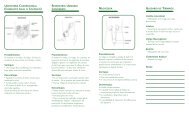Continent Diversion - United Ostomy Associations of America
Continent Diversion - United Ostomy Associations of America
Continent Diversion - United Ostomy Associations of America
You also want an ePaper? Increase the reach of your titles
YUMPU automatically turns print PDFs into web optimized ePapers that Google loves.
Cramps<br />
I had my fi nal j-pouch surgery one month ago and<br />
I am doing OK except for really strong cramps. Is this<br />
normal? Should I take something for the cramps? Will<br />
they decrease over time?<br />
Dear New Patient,<br />
The cramps will usually decrease over time. They<br />
may result from a number <strong>of</strong> causes. Three <strong>of</strong> the more<br />
common reasons are irritable bowel syndrome (IBS),<br />
adhesions, or medications. Medications such as pain<br />
meds, psychiatric drugs, sedatives, or bowel agents such<br />
as Imodium may produce cramps at higher doses.<br />
The fi rst step is to review your medications and see<br />
if some can be eliminated or changed. Adhesions are<br />
common after any abdominal surgery. The presence<br />
<strong>of</strong> adhesions may cause some cramping as they may<br />
partially kink the bowel. These usually s<strong>of</strong>ten with<br />
time and the symptoms will improve. Irritable bowel<br />
syndrome is a motility disorder <strong>of</strong> the small bowel. It is<br />
<strong>of</strong>ten helped with changes in diet (usually adding fi ber<br />
helps) or medications. Your primary care physician or<br />
gastroenterologist can <strong>of</strong>ten <strong>of</strong>fer some suggestions.<br />
Drainage<br />
I am a little over two months out from having a<br />
k-pouch. I am still having a good deal <strong>of</strong> drainage from<br />
the barbie/ken butt area. Is this normal?<br />
Dear New Patient,<br />
A proctocolectomy removes the colon, rectum<br />
and anus. The surgery on the anus can be performed<br />
in a number <strong>of</strong> ways that range from removal <strong>of</strong> the<br />
anal lining to removing the anal lining and the anal<br />
muscles.<br />
The more tissue removed, the larger the residual<br />
cavity that is left to heal and the larger the perineal<br />
incision. If the cavity doesn’t heal completely, fl uid may<br />
form which will <strong>of</strong>ten drain out the perineum. This tissue<br />
fl uid drainage in not “normal” but not uncommon. The<br />
drainage usually decreases with time and eventually<br />
stops altogether.<br />
If the drainage continues, your surgeon should<br />
inspect the area to be sure that a residual cavity is not<br />
present or that all the intestinal lining tissue was not<br />
completely removed. Small cavities can <strong>of</strong>ten be treated<br />
with a chemical sclerosing agent such as silver nitrate<br />
sticks. Larger cavities may need to be treated surgically.<br />
One or Two Steps?<br />
I had my colon removed several years ago, but now<br />
I’m going to try the j-pouch. My surgeon said the surgery<br />
will probably be a one-step procedure. I’ve been told<br />
that the two-step is better. Is this true?<br />
Dear New Patient,<br />
An elective (planned) restorative proctocolectomy<br />
or ileoanal pouch procedure can be performed in<br />
one or two stages. With a two-stage process, the fi rst<br />
operation involves removing the colon and upper<br />
rectum, using small bowel to create a pelvic pouch<br />
which is connected to the anus, and creating a diverting<br />
loop ileostomy. The second stage or procedure involves<br />
closing the ileostomy.<br />
With a one-stage procedure, the diverting ileostomy<br />
is not used. Restorative proctocolectomies are<br />
challenging and complicated procedures. Patients who<br />
need these operations are <strong>of</strong>ten ill, malnourished, and<br />
on immunosuppressive medications. The complications<br />
associated with the procedures are signifi cant. The<br />
ileostomy diverts the intestinal contents from the pouch<br />
and provides time for the pouch to heal.<br />
This diversion does not prevent complications such<br />
as a leak from the suture lines or infections. However,<br />
diversion does affect the signifi cance <strong>of</strong> complications.<br />
In other words, a leak from an undiverted pouch<br />
can produce serious and potentially life threatening<br />
problems. A leak from a diverted pouch is <strong>of</strong>ten<br />
asymptomatic.<br />
A two-stage procedure does have some<br />
disadvantages. Two operations and hospitalizations are<br />
required and each has a certain risk <strong>of</strong> complications.<br />
During the 6-12 weeks between procedures, the patient<br />
has an ileostomy which can produce skin irritation and<br />
electrolyte abnormalities.<br />
The decision to choose one or two stages must<br />
involve the surgeon and the patient. Factors to take into<br />
account include, the experience <strong>of</strong> the surgeon, the<br />
patient’s risk factors and tolerance <strong>of</strong> risk. The decision<br />
is not always easy and must be individualized. However,<br />
the majority <strong>of</strong> procedures performed are usually<br />
two-stage procedures.<br />
<strong>Continent</strong> <strong>Diversion</strong> New Patient Guide The Phoenix 5








